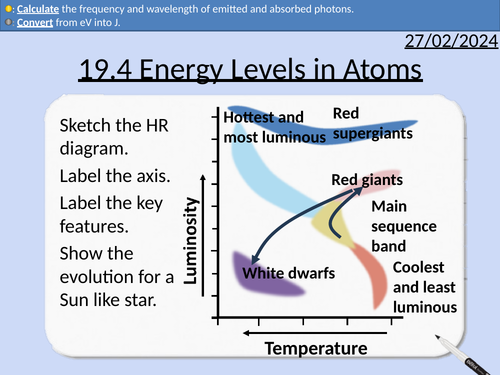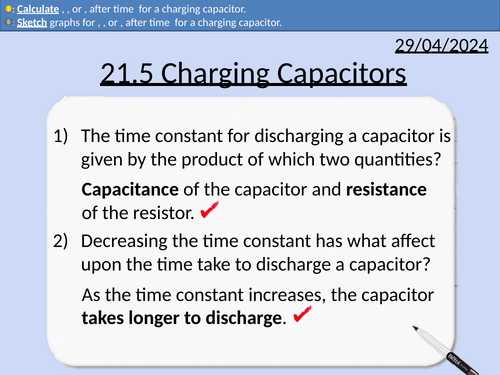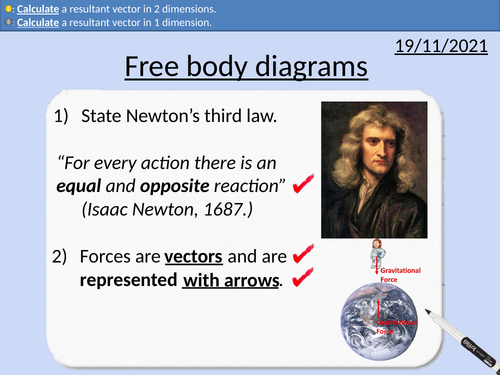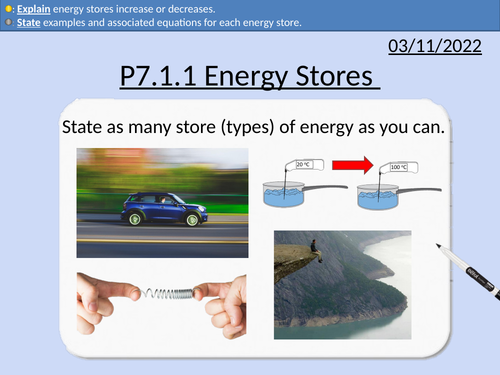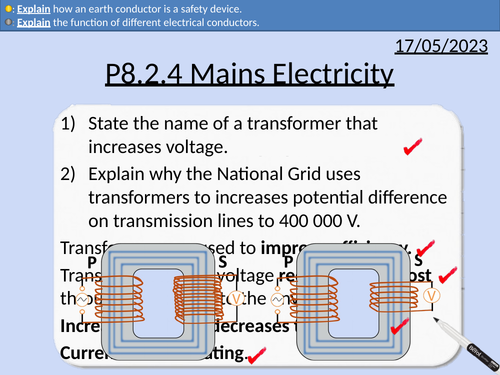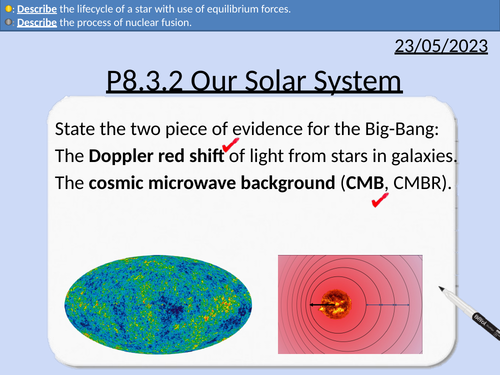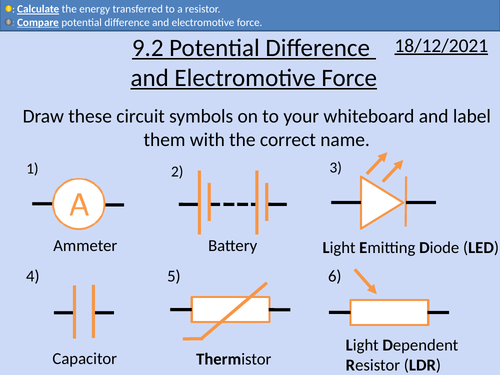497Uploads
169k+Views
72k+Downloads
All resources

OCR A level Physics: Energy Levels in Atoms
OCR A level Physics: 19.4 Energy Levels in Atoms
Module 5 Newtonian World and Astrophysics
This PowerPoint is a whole lesson included with student activities, animated answers, homework questions with answers provided.
This lesson covers:
Atoms have different electron arrangements
Ground state energy
Bound electron states being negative
Converting between joules and electronvolts
Calculating the change of energy between energy states
Calculating a photon’s frequency and wavelength

OCR A level Physics: Charging Capacitors
OCR A level Physics: 21.5 Charging Capacitors
Module 6 Particles and Medical Physics
This PowerPoint is a whole lesson included with student activities, animated answers, homework questions with answers provided.
This lesson covers:
Explaining how capacitors charge with a resistor in series
Explaining how 𝑉, 𝐼, or 𝑄, change with time 𝑡 for a charging capacitor.
Sketching graphs for 𝑉, 𝐼, or 𝑄, after time 𝑡 for a charging capacitor.
Calculating 𝑉, 𝐼, or 𝑄, change with time 𝑡 for a charging capacitor.

OCR A level Physics: Faraday's Law and Lenz's Law
OCR A level Physics: 23.5 Faraday’s Law and Lenz’s Law
Module 6 Particles and Medical Physics
This PowerPoint is a whole lesson included with student activities, animated answers, homework questions with answers provided.
This lesson covers:
Magnetic flux density and magnetic flux linkage
Faraday’s Law
Lenz’s Law
Alternators and induced e.m.f.
Graphs of flux linkage and induced e.m.f.

OCR A level Physics: Alpha-particle Scattering Experiment
OCR A level Physics: 24.1 Alpha-particle Scattering Experiment
Module 6 Particles and Medical Physics
This PowerPoint is a whole lesson included with student activities, animated answers, homework questions with answers provided.
This lesson covers:
Developments of scientific models
Thompson’s plum-pudding model
Rutherford’s nuclear (planetary) model
Rutherford’s experiment, observations, and conclusions
Using Coulomb’s law to find the minimum distance between particles

OCR A level Physics: Half-life and Activity
OCR A level Physics: 25.3 Half-life and Activity
Module 6 Particles and Medical Physics
This PowerPoint is a whole lesson included with student activities, animated answers, homework questions with answers provided.
This lesson covers:
The reason why radioactive decays are considered random and spontaneous
Rolling dice being a good analogue for radioactive decays
Definition of half-life
Determining half-life from a graph.
Calculating half-life from a table of data.
Activity of a sample in Bq
The decay constant derivation

GCSE Biology: Carbohydrates, Proteins, and Lipids
This presentation covers OCR Gateway Biology 9-1 B1.3.1 Carbohydrates, Proteins, and Lipids
This PowerPoint is a whole lessons included with student activities and animated answers.
The three main macronutrients - carbohydrates, proteins, and lipids
Names of enzymes - carbohydrase, amylase, protease, lipase
What the macronutrients are broken down into - simple sugars, amino acids, fatty acids and glycerol.
Metabolic rate
Food tests and the positive results

GCSE Physics: Electrical Power
This presentation covers OCR Gateway Physics 9-1 P3.2.8 Electrical Power.
Definition of power
Standard form for kW and MW
The three equations for power
Rearranging electrical power equations
Derivation of P = I^2 R with subsitution
Students questions and worked solutions

GCSE Physics: Acceleration
This presentation covers OCR Gateway Physics 9-1 P1.2.3.
Content covered:
Definition for acceleration
Worked solutions
Students problems with answers
Exam style question with mark scheme

GCSE Physics: Distance, Time and Speed
This presentation covers material for OCR Physics Gateway 9-1 P2.1.1
Covered:
Measuring and calculating
Accuracy of stop watch vs light gate
Conversion of units
Exam style question
Worked examples
Students questions with answers
Bundle

GCSE OCR Physics: P1 Matter Full scheme
All resources for P1 GCSE OCR Physics Gateway 9-1.Triple and combined (Higher and Foundation) is covered in this material.
Includes:
End of topic test
Scheme of work
Development of the atomic model
Density
Temperature
Specific Latent Heat
Specific Heat Capacity
Pressure and Temperature
Pressure and Area
Pressure are Volume
Atmospheric Pressure
Liquid Pressure
Sinking and Floating

GCSE Physics: Free Body Diagrams
This presentation covers GCSE Physics OCR Gateway P2.2.2
Vector Addition 1D
Vector Addition 2D - scaled drawings
Vector Addition 2D - finding angles with a protractor
Resultant vectors and acceleration
Student problems with answers.

GCSE Physics: Simple Machines and Gears
This presentation covers OCR Gateway Physics 9-1 P2.3.5 Simple Machines
• Uses of simple machines
• Simple machines as force multipliers
• Mechanical advantage equation
• Gears – ratios, speed, direction
• Rearranging equations
• Exam style questions with solutions
• Student problems with answers

GCSE Physics: Energy Stores
This presentation covers OCR Gateway Physics 9-1 P7.1.1 Energy stores
Examples, units, and equations of each energy store:
Kinetic
Gravitational potential
Elastic
Thermal
Magnetic
Electrostatic
Chemical
Nuclear
Student activities with full worked answers also included.

OCR AS Physics: The Photon Model
OCR AS Physics A: The Photon Model is a part of the Module 4: Electrons, Waves, and Photons.
Full lesson PowerPoint with worked examples and homework with complete worked answers.
Energy of a single photon
Converting from electron-volts to Joules.
Frequency of the electromagnetic spectrum
Determining Plank’s constant with LEDs
Threshold potential difference difference

GCSE Physics: Electrical Resistance
This PowerPoint presentation with worked examples and student questions covers:
• Ohm’s law and units
• Proportionalities
• Resistance in series
• Rearranging equations
• Calculating resistance with ohm’s law

GCSE Physics: Mains Electricity
This presentation covers OCR Gateway Physics 9-1 P8.2.4 Mains Electricity
This PowerPoint is a whole lessons included with student activities and animated answers.
Domestic Electrical Supply being 230 V, AC at 50 Hz.
Direct potential difference and alternating potential difference.
Reasons for insulation on wires.
Potential Difference between different conductors.
Function of the earth conductor.
Double insulation and no earth wire.
Reasons the live wire is dangerous.
Reasons why live to earth is dangerous.

OCR AS level Physics: Current and Charge
OCR AS level Physics: Current and Charge is a part of the Module 4: Electrons, Waves, and Photons.
Presentation come with worked examples, solutions and homeworks.

GCSE Physics: The Solar System
This presentation covers OCR Gateway Physics 9-1 P8.3.2 Our Solar System
This PowerPoint is a whole lessons included with student activities and animated answers.
Structure of the solar system
Nuclear Fusion
Evolution of large stars
Evolution of Sun like stars
Gravitational force and force from nuclear fusion

OCR AS level Physics: Potential Difference and Electromotive Force
OCR AS level Physics: Potential Difference and Electromotive Force is a part of the Module 4: Electrons, Waves, and Photons.
Presentation come with worked examples, solutions and homeworks.
Calculating the base SI units for volts
Comparing potential difference and electromotive force (emf).
Circuit diagrams for measuring potential difference and emf.
Calculating energy dissipated in a circuit.

OCR AS level Physics: Derived Units
OCR AS level Physics: Derived Units is a part of the Module 2: Foundations of Physics
Full lesson PowerPoint with worked examples and homework with complete worked answers.
Indices Notation
Converting from Celsius to Kelvin.
Determining base units from derived units.

